|
MESSYBEAST AND MOGGYCAT
|
|
MESSYBEAST AND MOGGYCAT
|
This page is dedicated to my past and present cats. Most of my cats were adopted as unwanted elderly cats or temperamental cats. A few were "in transit" as foster cats. The oldest or most infirm were adopted so that their twilight time could be spent in comfort and their passing would be made easy when the time came. Most were from Chelmsford & District Cats Protection (League) though a few were strays which I rescued. The departed ones are sadly missed, the current crew are greatly cherished.
Sarah Hartwell
KITTY I
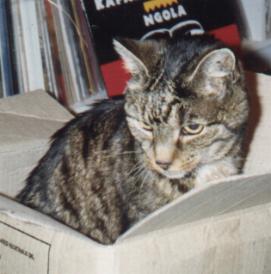
Kitty came from Chelmsford & District Cats Protection League in 1988. A petite mackeral tabby she was reckoned to be 12+ years old and had come from an elderly lady who had been unable to care for her due to failing eyesight and health. I provided some photos for her previous owner and later received a phone call and some history about Kitty. Kitty settled in at once - in fact after a couple of hours she wanted to interview neighbours about Kitty-sitting!
Kitty was more than 12 years old for a start! Her proper name was "Keta" after the salmon, because of her pattern. She had been owned by a couple who divorced and didn't want the cat any more. They gave her to a colleague at work and he later decided he didn't want the cat any more. By then she had moved in with the elderly lady who cared for her until health problems made this impossible. She was relinquished to Chelmsford & District CPL. My ex-husband and I wanted "older cats which no-one else wants".
Kitty was sweet-natured, love to play with local children e.g. riding in prams, loved visiting neighbours especially when Dennis next door was housebound through back injury. She bullied local dogs, subdued the builders' "guard dog" (Welsh Springer Spaniel) into becoming a Kitty cat-bed and entered the house of a local labrador and ate its food (the dog began to look both ways when exiting the back door).. She became deaf and later senile. A collar tag meant she was returned from her senile ramblings (to the end of the street to visit friends, but she forgot the way home). The collar also meant we received phone calls asking if it was okay to return Kitty after the 10 o'clock news and they' pop her through the cat flap!
Eventually her boniness made even the beanbag uncomfortable for her. One night in 1991 she stopped eating. That night we said goodbye to her and that the next day Dr Vet would help her on the final journey. We told her she had been a good cat and deserved to rest now and that her old lady would be waiting for her on the other side. She never made the vet visit. She must have known we had "let go" and that she was free to leave us. The following morning we found her dead under the bed.
Kitty was buried in the front garden because the local children wanted to put flowers on her grave. Some neighbours whom Kitty visited gave floral tributes.
SCRAPPER
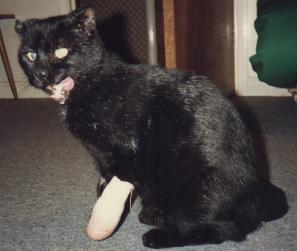
Scrapper arrived with Kitty I in 1988. He was a big tough ex-feral trapped and snipped aged 10. He had beaten up other cats in the area, but was now down on his luck. He must have been a pet originally and been allowed to stray and go wild. Neutered, cured of fleas, ringworm and a variety of fight and bite wounds, he had sat in the cat shelter for many months awaiting a person who looked beyond his mangled features. He was a black cat but rather dusty and motheaten. Scrapper sat forlornly in a cat basket for several days, unwilling to leave it while we were there. After a week he suddenly decided that enough was enough and came to watch Blue Peter with me on the sofa. From then on he was my little black shadow and walked to heel!
Scrapper was cross-eyed, had a cauliflower ear (the other ear lacked fur and was like leather) and a tail which had been broken and set crooked with no sensation in the end third of the tail (disconcerting if you trod on it and he didn't feel it). He had to have an infected ingrowing dew claw removed and learned to use his bandaged foot as a club. Once it healed, he continue to limp - but only when he wanted sympathy! He loved to play with a cat-tease toy and would retrieve it from a bookshelf and drop it at my feet when he wanted a game. However he had problems with stairs, having never encountered them before.
Scrapper was the most intelligent cat I have owned. He had lived on his wits as a feral and been intelligent enough to opt for the soft life as a domestic cat after many years living rough. Doors were hooked open - he always knew which way they opened. He loved to talk to me. He "talked" in full sentences of varied sounds interspersed with pauses in clear imitation of the rhythm of human speech.
Among his many idiosyncracies he developed a lasting relationship with a blue jumper which he humped frequently. After I made a daisy chain and put it round his neck, he developed a hatred for daisies and patrolled the lawn, beheading any daisy he could find. He was frightened of the dustbin men and of men wearing boots, even of my ex-husband if he wore boots. He became mentor and big brother to Aphrodite, our clueless feral kitten, and they hunted as a team. He walked to heel and slept wrapped around my head. He loved to suck meat scraps off of lamb or beef bones. He loved crisps, yoghurt and anything liberated from a dustbin. He had a favourite thinking place where he sat on the lawn looking confused.
In the summer of 1991 Scrapper became listless and thirsty. His urea count was high and he required a prescription diet for advanced kidney failure. In true wild animal fashion he had hidden his symptoms for a long time. There was no way an ex-feral could be kept on a restricted diet, he would not have understood it. It would have been keeping him going for our sake, not his. Scrapper was put to sleep and laid to rest in his favourite "thinking place". Strangely, daisies began to grow in abundance on that patch of lawn. Even more strangely, every daisy-like flower on a feverfew plant was found severed a few mornings later. But the strangest thing of all was hearing Scrapper's paws on the bedroom carpet the very evening he had been euthanised. Our dear little Scrap-Cat, it had been so sudden for him that he didn't know he had passed over.
I felt Scrapper visit me a few times and I am sure we will meet again.
APHRODITE (AFFY)

A colleague asked me to trap a feral kitten in his garden in summer 1988. Being very green at the time i turned up with a basket and discovered a 5 month old cat. Luckily she was starving and I could scruff her and stuff her in a basket. She was also a bit to thick to be truly feral and we later found out she had been dumped by a person who regularly dumped half-Persian kittens in that area (close to farmland). She was apricot coloured with a fluffy tail. We called her Aphrodite because she was beautiful but untouchable like a love goddess. She was nicknamed "fizzy orange cat" because she fizzed and exploded if picked up, and "squitten" because she was a kitten with a fluffy squirrel tail. She grew up into a "Squat" (rhymes with "cat") and became a most devoted companion who benevolently saw many old cats join our household and pass away. She knew she was our "forever cat".
It took 18 months to house-train her. We tried every method in the book, but she did not understand the concept of litter tray. We eventually replaced the hallway carpet due to urine damage. As long as she had access to outdoors, she was clean indoors. One day Affy saw Tulip (another rescue cat) use the litter tray. The penny dropped. Affy jumped in and did a big wee. She looked so pleased with herself for finally sussing it out. From then on, every time we supplied a tray for an old or ill cat, Affy wanted to use it too; but never for solids. Solids were left like landmines on the lawn, ready to explode in the face of whoever mowed the grass (cat mess and Flymo are not a recommended combination).
She tagged along after Scrapper who had no option but to mentor her. Sadly he had little to work with and little time to teach her. Kitty mostly ignored her. Affy was the cat who fell off of work-surfaces; she was the one who ran into a wall at point-blank range; she brought home leaves and pieces of stale bread as gifts and she slept under the covers like a warm, purry teddy bear who loved to be cuddled tightly. Her face was a permanent smile and when the fizzy stage was past she was affectionate, cuddly and loved to be groomed. She growled at claw-clipping time but never meant it really. She could be bought off with chicken and cheese. She sulked if she didn't get a tuna treat after Friday's shopping trip. She was scared of blackbirds and nervous of butterflies. Her hunting record totalled 2 items per year, most of which were released unharmed.
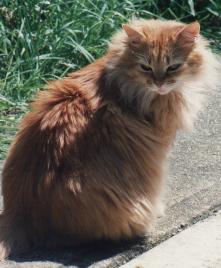
Affy was a large cat, bordering on "fat" but always active and a moderate eater so the vet didn't mind too much. Her fur became long and ginger and I loved to bury my face in her warm belly. She loved belly rubs and loved to sunbathe on the parcel shelf of the car (with its windows open so she could get out any time she liked). She answered at a run to "Affy-Affy-Affy" or to "Squat" but knew that "Aphrodite" meant she'd done something she should have and arrived at a slow amble, generally looking the other way. She loved "big brother" Scrapper and the pair often played tag back and forth upstairs and this led to Scrapper becoming very fit.
One morning we got home and Affy greeted us. She was a little slow (we had timed her). Usually she looked a bit dishevelled and bleary as though she'd just woken up. This time she passed out and wet herself. At first the vet thought it was an infection, but a few days later she went in for tests. Every time she moved about she collapsed or fainted. The vet kept her in for tests and diagnosed cardiomyopathy. He stabilised the condition temporarily, but the medication did not work for Affy. We nursed her for a week, confining her to a cage but she was unhappy. Fluid began to accumulate again and she was put to sleep in 1999 aged 10 years 11 months. She fought the vet and he apologised that it was not the most peaceful ending; however that was Affy to a T. She came in like a tiger and she left like a tiger.
A form of cardiomyopathy is found as a hereditary condition in some lines of Persian cat. It classically strikes at the 10 year stage. As well as her sweet features and long fur, Affy had inherited this from her Persian side.
HOLLY
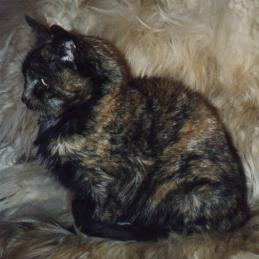
Holly was only with us for a few months. She was adoped 1991 during Christmas and had been a stray picked up by the CPL. Christmas is a quiet time in my household and is one of my few holidays due to factory shurdown. As a CPL worker I am known to be "safe" to take home cats from the shelter at this time. Holly was in her teens, a brindled tortie with a pale front paw which looked as if dipped in ice cream. She was deaf and had a blank expression which i later recognised as characteristic of senility (something not well recognised in cats at the time). At first, Holly settled in well and her occasional litter tray lapses were seen as accidents. Then she began to wander and after being retrieved from up to a mile away (sitting outside a doorstep or having walked into a shop) she was under house-arrest. She always tried to head in the same direction.
Her litter-tray lapses made house arrest untenable and it was impossible to keep her indoors while allowing Affy outdoors (a necessity as Affy would only defecate outdoors). Sadly holly was returned to the shelter with a full explanation. I paid towards her upkeep in a large enclosure with other old cats. She tried to wander (the same direction again) but was now safely confined. She lived happily, if blankly, for some weeks before succumbing to saddle thrombus in spring 1992. She is the only cat not buried at home.
TULIP
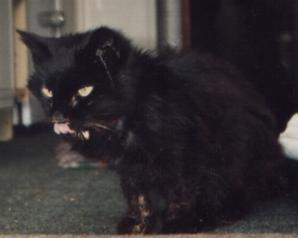
Tulip arrived with Holly in 1991. She had been neglected and was alive with fleas, very thin and the previous owners had wanted to club her to death with a shovel. Unlike Holly she was not at all senile and her condition was due more to continued neglect than to age. Tulip was a cat who was simply worn out from life.
Tulip was deaf and fragile and opted to never go outdoors; but she always used the litter tray and was evidently delighted to have a safe, warm indoors home at last. There is little to tell of Tulip and she was never any trouble. She was just grateful. She sat on my lap for affection and she loved smoked salmon and a spoonful of cream. At her stage of life these things could do her no harm and we knew she had little time left. On the day in 1992 we took Holly back to the shelter we also lost Tulip.
That day Tulip played for the first time. She played with a ping-pong ball in a cardboard box with holes cut in it. We later realised that this was her way of thanking us for a few months of good times to compensate for everything she had endured earlier in life. After playing, she walked slowly and unsteadily upstairs, a small frail black cat. She lay on her cushion by the radiator in the study. A few hours later she had single convulsion and fell off the cushion unconscious. Being a Sunday, a vet visit was not an easy option. I laid her on a soft towel by the radiator and I knew she was in a coma and beyond feeling much. I stroked her gently and dimmed the light, leaving her to sleep peacefully. I checked on her every few hours as the coma deepened. She passed away peacefully in this sleep a few hours later.
I had known it was her time. She had shown the characteristic "can't hold the head up" posture when at rest. The most telling sign was a dream where I had watched Scrapper walk into the kitchen and then watched him walk out, followed by another, smaller black cat - Tulip. If Scrapper had come to find her, then Tulip was safe.
TINKER
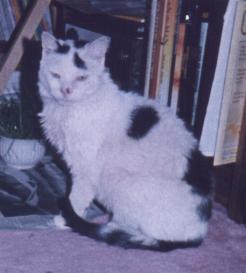
I think I got Tinker under false pretences! He joined me in 1992 and was apparently 12+ and turned out to be "19 if he's a day". His elderly owner had died and the owner's son couldn't take on the cat and had relinquished him to the CPL. Tinker had caught cat flu and been nursed through it. He was a very macho cat who sadly was only with us for a few weeks. He slept on the bed and was a gentleman to Sappho who had been adopted at the same time. He kept pinning her down and washing her face. She objected, biffed him and he looked hurt. Then it began all over again.
I met the previous owner's son a few weeks after adopting Tinker and shortly before Tinker suddenly and unexpectedly died. Tinker had never been one for sleeping on the bed and usually slept on a chair downstairs. It seemed that Tinker had discovered that we had different house rules and was making full use of the sleeping-on-bed clause!
One early morning after only a few months with us, Tinker got up for an early breakfast. I heard a crash and thought nothing more of it. When Tinker did not return to bed I went down to see if he was okay. He had died, obviously very suddenly, his head in his food bowl. Sappho was evidently delighted (no more face washing). He was only with us for a few weeks, but Tinker was a real gent, treating the other cats with courtesy. He had recovered from cat flu at an advanced age and had put on condition. Apart from a little muscle wastage in the hindquarters (common in old age) he was a big muscular cat. He obviously had not suffered and he was laid to rest in the garden. For a long time afterwards, Sappho sat on his grave. Probably to get her own back for all the face-washing sessions.
SAPPHO
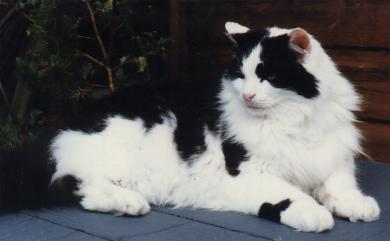
Sappho "Fufflecat" Hartwell arrived in 1992 at the same time as Tinker and we had gotten her vaccinated against cat flu as a precaution when adopting her. I had met Sappho and heard her story from the shelter warden whom I met in the vet surgery by accident. I decided to adopt her, having recently lost Tulip. For me, the best way to memorialise a departed cat is to adopt another needy cat.
Sappho's previous owner had been an alcoholic woman who had died during the winter. The police broke into the house and found the body and two cats who had been in the house for a few days. Sappho was clinging to her owner and apparently trying to wake her up. Rather than call an animal rescue shelter, the police tossed the cats out into the snow. Luckily a neighbour adopted the male cat (Socrates, who became Socks), but could not afford to have Sappho who had health problems, mostly due to being an emotional wreck. She was thin and had eczema. Her black areas were brown and her white areas were yellow. Her face and eyes were haunted and she was very clingy. I was only able to take her when the skin problems were under control, though they were always a recurring problem.
For many months, Sappho woke me up at night, frantically nudging me awake to make sure i had not died. She made it clear she was my cat, but ex-hubby was considered a good source of titbits (mostly frozen yoghurt). Some nights she had nightmares and hid under the covers by my knees, whimpering and crying for up to an hour before being reassured. The memories faded and she became a plump, contented cat whom my friend Sheila called "The Cushion" because she flopped on the sofa like a furry black and white cushion.
She loved a tummy rub and this saved her life when she first had a mammary tumour. I felt it while it was a small lump and it was removed. Such tumours are rare on spayed cats. She was on Ovarid for a skin problem but this caused side-effects including urinating in the house and food-carrying/calling for an imaginary litter of kittens. We think she had once had kittens and they had been taken from her too young. When we took on feral kittens for taming, Sappho refused to have anything to do with them and Affy was scared of them! Due to side-effects, we switched from Ovarid to Efamol Evening Primrose Oil (dropper bottle) and rigourous flea control; the skin problem remained under control from then on.
Sappho and Affy made quite good friends. The only cat Affy had really played with previously had been Scrapper. Affy now liked to wait behind a door to smack Sappho as she went by. In return, Sappho lolled on the sofa and smacked Affy as she walked by. Sometimes they played a sedate version tag. Their smacking was never malicious, more like two older people bickering light-heartedly.
Sappho developed Inflammatory Bowel Disorder which we controlled with medication and diet for as long as possible. She then developed another tumour and recovery was difficult because she haemorrhaged. She had also become deaf and was going senile. When other cats hissed at Sappho she sat there wondering, in her silent world, why they were yawning at her! She enjoyed another summer thanks to the surgery, but the tumour re-grew and spread to other sites around her abdomen. Her bowel problem caused her to have liquid motions and her growing senility meant she missed the litter tray. We had reached the end of the road in 1997 and my Cushion-Cat was put to sleep one morning.
ARCHIE
Archie was with me for only 3 days having been picked up as a feral in 1992. He turned out to be a badly matted and elderly domestic cat who was frantically happy to be rescued. He was longhaired white with ginger patches on the face and tail. At the shelter he was drinking too frequently and tho my ex-husband was none-too-happy, I brought him home for observation. By then i was familiar with the signs of kidney disease and Archie was put to sleep three days later.. he had, at least, known 3 days of affection and care after being a stray. However, i wished that the kidney test had been carried out much earlier as he had undergone neutering surgery and dental surgery, only to be euthanized a week later.
KITTY II
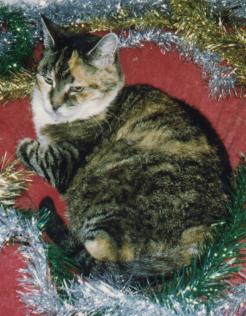
Kitty II came to us in 1992 - this was obviously "a good year for adopting cats".
When an old man died, his grown up children did not bother to take his very old cat to a shelter or even take her to be put to sleep. They simply chucked her out to fend for herself. She was eighteen and a half years old, had a benign oral tumour, shortness of breath and a mild heart murmur. She could not hunt, could barely scavenge and she was found collapsed with dehydration. Neighbours took her to a vet - why couldn't they have done this earlier? She luckily ended up at a vet who rehydrated her and restored her (water and good food was all she really needed). The first animal society he contacted told him he might as well put her down. Luckily she went to the CPL. This time I dragged ex-hubby to the shelter to meet her and he agreed to take her home. She had been called Georgie by the shelter, but we called her Kitty since this was a common name and she would probably have been called by it on occasion (i.e. "Here kitty-kitty").
Kitty II began to purr the moment her paws touched the carpet in the "settling-in room". She continued to purr like an engine until the moment she died. She was a very "traditional" cat who was a traditional tortie-tabby and white colour. She liked real cat things and was active (albeit not very fast), alert, curious and friendly. Her stiff-legged gait led to her being nicknamed "clockwork kitty" by my parents who also described her as an "old fashioned cat". She liked to lie on her back and be scooted along the floor. Despite her oral tumour, which slightly disfigured her lip and nose, she still had a full complement of teeth. She took over Scrapper's bean bag.
Kitty II was perfectly content to share house with Affy and Sappho. They tolerated each other due to enough warm sleeping places. She reached the grand old age of almost 21 years with only minor health problems. Sadly, in December 1994, her heart let her down at the end. Despite looking fit as a fiddle with a gleaming coat, her heart was failing and her chest was filling with liquid causing breathing problems. She had begun to sleep awkwardly and to hide in the warm airing cupboard. This was out of character and the vet check revealed the heart failure. Kitty II purred throughout the vet examination and she was purring as the needle of barbiturate was injected. Her purr only halted when she finally left us. She was buried in the back garden and the grass grew in a darker green above her, in the exact shape of a curled up cat. We hope she is reunited with the old man who had obviously cherished her and whose care had allowed her to reach such an advanced age.
SPOOK
Spook (not pictured) was a temporary resident who came in from the cold. He was a grey cat with a peach coloured belly who had started entering the house to raid the foodbowls. After first shooing him out, we realised he was genuinely homeless, having strayed from a mile away. We put a collar on him saying "Is this cat a stray, phone <number>" and had no response for 2 weeks. It turned out that the previous owner had adopted a Persian and a "shorthaired Persian" (i.e. she knew absolutely nothing about cats, since Spook was very obviously not Persian in body type!) and the shorthair had run away from home. But it didn't matter because he was quite happy living in a school field nearby. In fact he was quite unhappily trying to find a home to take him in.
Once he realised we would let him in, he inspected the place like a cat who intends to settle in, and he moved into the spare room under the bed. He was very polite, eating last and never hassling Affy, Sappho or Kitty II. He was the perfect house-guest but I was not permitted a 4th cat in residence. He loved belly rubs and liked to sit in the bathroom when i bathed. This brought him into conflict with Affy who believed that bathtime voyeurism was her privilege. Once we had confirmation that Spook was homeless, we booked him a space at the shelter (this became urgent as neither ex-hubby nor Affy wanted him around for long) and he was very quickly homed to a helper there.
He was renamed Simba and is apparently spoiled rotten and has become very demanding. He counts as a temporary member of my feline family.
SHEILA
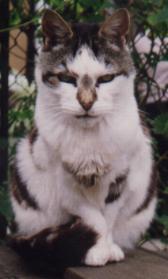
Sheila had been living in the shelter's pensioners pen and was a rickety old cat, white with tabby patches. She was named after a former warden because both cat and human had back problems. When Kitty II died, I took on Sheila in December 1994. She had been very thin at first, but was putting on weight and condition.
Inside a house and spoiled rotten like all my cats, Sheila quickly put on condition and began to glow with health. She loved the garden, especially the old hutch which provided a convenient outdoor shelter in the summer. Unfortunately, she was not to be with us for long.
In the summer of 1995, Sheila developed severe diarrhoea - smelly and dark, indicating a serious problem. Although the vet managed to stop the diarrhoea, Sheila had no appetite. She sat looking very dignified, evidently simply waiting for the end to happen. She spent one night at home with me before returning to the vet the next day. She joined the others beneath the back lawn.
Before her illness I had used a standard flea spray in the living room (Canovel). Although the vet could not find a cause of the diarrhoea (not liver or kidneys), the diarrhoea began after I treated the furnishings. Just to be safe, I have not used that preparation again, nor any other flea preparation containing the same active ingredient.
MOTLEY & RUBIK
While I had only Affy and Sappho, I accepted 2 feral kittens for taming though sadly I don't have any photos. These were tortie sisters aged 10 weeks. They lived for a while in a pen in the living room where Affy made her displeasure clear and Sappho sulked and moved upstairs for the duration. We had hoped that Sappho's Ovarid-driven maternal instincts would win the day, but it seemed that "real" kittens were an entirely different matter!
Motley tamed first and was rehomed, but Rubik was the fiery one and took much more work on her own. She was rehomed but the couple decided they couldn't cope with finishing her taming after all so she came back to me. The experience seemed to sober her up a great deal and she was transformed almost overnight into a "real kitten". She seemed relieved to be back with me. Afer a week she went back to the shelter to be rehomed from there; she remained a friendly affectionate kitten at the shelter and was homed to sensible people.
QUEENIE
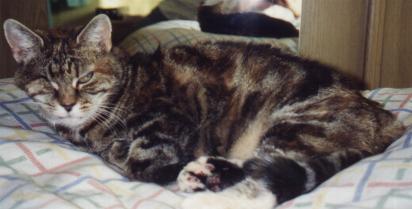
After Sheila died, I still had Affy and Sappho and wasn't planning to take on another oldie at once. Frankly I needed a rest from the emotional rollercoaster. However I met Queenie in August 1995 when visiting a friend. The 15 year old cat had been living as a stray in a block of flats in Dagenham and an old lady called Queenie had been feeding her. However Queenie the cat had a damaged eye and needed vet treatment so a CPL branch took her and she ended up with my friend in foster care while being treated. At first she was bad tempered, but once they eye was removed she calmed down. She must have been in some pain. She also hated dogs and my friend had to find her a permanent home with no dogs. Ex-hubby agreed to take Queenie on trial, especially as she was a polydactyl cat and therefore "different".
Queenie was a large tabby cat with an attitude and huge paws. When ex-hubby accidentally let her meet Affy, she beat up poor Affy quite badly. Luckily Affy was a very forgiving cat, used to meeting bad-mannered cats and easily bribed with tuna. Queenie was eventually allowed to meet the other cats while she was on a walking harness. A water pistol soon taught her that beating the others up was not permitted. At one point we thought we would have to return Queenie because of her attitude, but the water-pistol training worked and she learned to co-exist with the others.
Always regal, Queenie liked to sit by the front door and watch life go by. She loved sitting on the garden chairs in summer and she slept on the bed most evenings; later adopting the sofa which became vacant after Sappho's death. She was 16 approx when we adopted her and by the time Motley moved in a year or so later, she was secure enough to accept other cats. Her only health problems were intermittent cystitis and the usual dental problems. Disconcertingly she liked to have her empty eye socket rubbed!
She suffered a saddle thrombus early in 1998 and was unhappy at losing bowel control on that occasion. Being a fighter, she mastered the art of walking up and down stairs while leaning on a wall for support. We resigned ourselves to losing her within 3 - 6 months, the usual prognosis after saddle thrombus. Queenie was more determined than that and though she had lost muscle tone in the hind legs, she learned a slightly wobbly gait and could manage a good lick when favourite foods were detected. She later became deaf and a little senile, forgetting whether or not she had been fed, but she remained clean and when forays outdoors became too arduous she used a litter tray when she was upstairs (when downstairs, the garden was an easy distance). We knew that 1999 was her last summer and hoped she'd make it into the year 2000 with us.
Cats' bodies close down when death is approaching. They quit eating or drinking as their digestive system closes down. 2 days before New year, Queenie stopped eating or drinking. Not even favourite foods (stewed pork) could tempt her. Though she looked headed for a gentle end, I knew that vets would be hard to find on Millennium Eve and what difference would a day or two make to a 19-ish year old cat? She was put to sleep late December 1999, after a final Christmas and when her own body had decided to call it a day.
MOTLEY

Motley was the cat who came in from the cold in 1999 at an estimated 6 or 7 years old (based on general condition). All summer she could be heard crying outside a neighbour's back door, lonely and frightened. It turned out that her previous owners (in the same street) had decided to shut her out for good. They sometimes put food out for her, but basically didn't care enough to contact a shelter. She was never registered as "Lost" and no-one responded when I advertised her as "Found". We placed an old beanbag in the open greenhouse and provided food on the back step. We called the little brindled tortie with the white chin "that motley-coloured cat" but she was too scared to come indoors.
Six months into this relationship with the motley-coloured cat, a friend with a very deep rumbly voice came to visit. By then, Motley would enter the kitchen to eat. For some reason the deep voice attracted her and she came into the living room. While we talked and ignored her (nervous cats need to be "ignored" until they approach you, you shouldn't approach them directly), Motley checked out the downstairs area. She found a cushion, sat on it and never left. She loved ex-hubby (she missed him for a few months when he left in 2001) and was deferential towards Affy and Queenie. She queued patiently behind Affy at the food bowl and she carefully avoided Queenie's temper, though by then Queenie had mellowed a great deal. When Affy died unexpectedly, Motley became our "token younger cat". When Queenie died in the winter, Motley found herself "top cat" after a very short "apprenticeship".
Motley remained top cat, but preferred to live downstairs (while Cindy lived mostly upstairs) and loved to watch TV. She watched entire programmes, losing interest during advert breaks and resuming her viewing after the adverts. The first time she did this was for "Oetzi The Iceman". Once she achieved top cat position, she became less tolerant of other cats and it took a while for her to accept Cindy. In 2005 she had a mammary tumour removed and recovered well, but in 2006 she had problems breathing and went temporarily blind in one eye. She stopped eating and drinking, lost interest in life and had problems with co-ordination and swallowing. She may have had other tumours and some form of brain damage. She was put to sleep aged 13 rather than being allowed to deteriorate.
Unlike the stereotypical "temperamental tortie", Motley was patient and loved people. She was sweet-natured and adored children and spent summer days sitting on various front lawns with neighbours' children. Up until her major operation, she sat outside when the children went to school or returned home and was often rewarded with stroking and titbits from lunchboxes. She never bit or scratched and she never bothered wildlife.
CINDY (CINDERS)
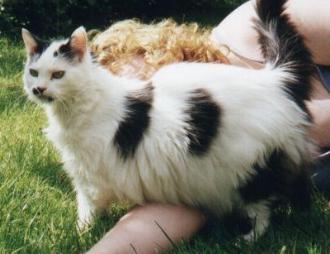
Cindy, or "Sheep", joined me in April 2000. At 8 years old, she was adopted not because of old age, but because of her temperament and the bond I formed with her while working at the shelter. Her owner had relinquished her due to the boyfriend not liking the cat. Cindy's fear of men suggested she had been kicked by the boyfriend. She had first lived in a house and enjoyed limited access to the garden. Later she had been moved to a flat and had been shut out most of the time due to the boyfriend. The neighbours objected to her making a nuisance of herself (crying and messing) in the stairwell. Cindy herself was disoriented and very frightened by her experiences. In the shelter she sat rooted in her basket hissing at anyone who opened her pen e.g. to feed or clean. Most people were scared off by the hissing. By then I had worked with cats long enough to read some body language. Cindy was not going to follow up her hissing - it was bluff. If I persisted, I could stroke her. I avoided eye contact (threatening) and "yawned" often (reassuring). Only 2 of us got this far. The other was the warden and she suggested I take Cindy.
For the first 2 weeks, Cindy hid under the bed in the settling-in room. I was allowed to crawl under the bed with her, but ex-hubby was rebuffed with hisses. Later she walked round the house with me, but only if I walked on all fours and she could walk under my belly like a lion cub under its mother's belly! Confidence grew though she never accepted ex-hubby and he never bonded with Cindy. Her owner had cared enough to provide detailed records of Cindy's likes and dislikes and details of previous dental work and of a rodent ulcer which had been removed. She disliked certain foods, but she discovered ones she'd obviously not tried before. Other dislikes were quickly changed - far from "tolerating" grooming, she enjoyed it greatly. She loved outdoors in summer. Apparently she was not a lap cat - but she loved sitting on my lap while I read books or watched TV or she sat at my ankles as I worked at the PC.
In October 2005, Cindy injured her eye, possibly on a thorn. In spite of treatment she developed an infected ulcer and there was no choice but to remove the eye. This was a huge risk because she was also hyperthyroid and had a rapid heartbeat. Although the eye was removed and her heart stood up to the operation, Cindy never regained consciousness due to respiratory failure.
ATHENA (THENIE)
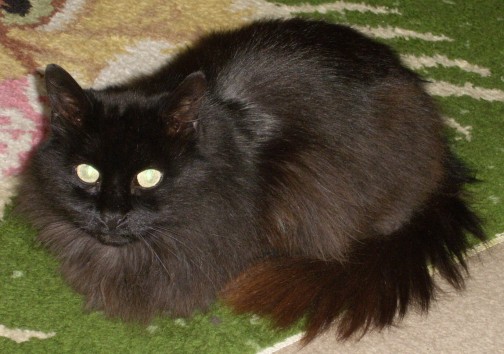
Black longhair Thenie used to sneak into my home on cold nights in the winter of 2004/2005 to sleep - the only evidence was fur and grime on a cushion. Eventually she came to an agreement with Motley and Cindy and moved in. It turned out that she belonged to neighbours in the next street (and was known by a different name), but they mainly kept their 4 cats outdoors and they didn't like Thenie's hunting habits. By mutual agreement, Thenie (approx 10 years old in 2004) came to live with me and visited her previous home at weekends for a while. I paid for her food and extensive vet bills.
She soon hunted much less, but was an excellent mouser and also took pigeons at times. She regarded small birds as a waste of effort. Right until the last few weeks she was very active, loved climbing trees and spent hot days sleeping on the garage roof. She was very affectionate and loves cuddles, but hindered work on the PC. After realising this meant she was shut out of the PC room, she learnt to snooze on the desk to one side of the keyboard. On cold nights she slept under the duvet or wrapped round my head. She loved valerian on toys, but was not enthusastic about catnip. When Cindy died, Thenie followed me everywhere for a while. She and Motley had established a truce (Thenie liked to wash Motley), but Cindy often smacked her. In 2006, Thenie became top cat following Motley's death. Having attained top position she made it clear she would not tolerate other cats. I was not able to adopt more cats during her tenure.
In 2006, Thenie had surgery for hyperthyroid. She recovered well and was soon back to her old self and a healthy weight. In 2008 the condition came back as the other thyroid gland went into overdrive. Tablets helped the thyroid problem, but Thenie continued to deteriorate. The vet diagnosed liver problems and a probably mass in her chest. No longer interested in food and having lost her zest for life, she was put to sleep in summer 2008. Even in her last days she greeted me in the morning and when I returned from work. For the first time in over 20 years, there was no cat in the house.
MUSTARD
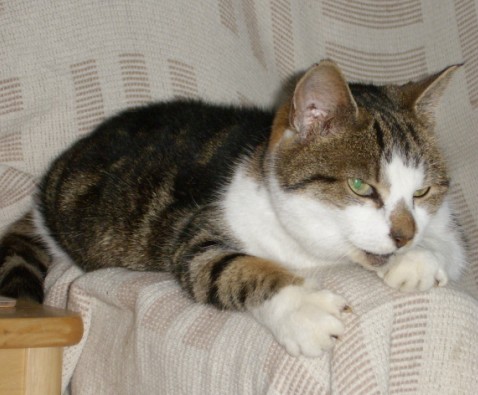
Mustard came from a colleague in 2008. His girlfriend moved in and proved so allergic to cats that Mustard and her housemate Kitty had to be rehomed at short notice - to short notice for local shelters. Being 10 or 11 years old, Mustard wouldn't have found a home in a hurry and my colleague preferred to rehome her to someone he knew and trusted with his cats. Tortie-and-white Kitty (Kitty III in this household) joined her a day later. Shortly after arriving it was obvius her teeth were in dreadful condition so they all had to be removed. The effect was to perk her up considerably as she could eat without it hurting. She put on weight and her coat became very glossy as a result. She also had a skin tumour removed from her thigh. The vet said this appeared to be an old wound that she'd worried at and caused a growth instead of it healing properly. Mustard tried to do the same with the surgery scar and had to wear an Elizabethan collar while it healed.
Although she loves cuddles and getting under the duvet in winter, Mustard has housetraining issues and will wee on things if not reminded to go outdoors regularly. The only time she'll use litter trays is if she's confined in a cage with a tray, otherwise she'll use the carpet, clothing dropped on the floor or even the bed. Despite several attempts at retraining, she really can't make the connection between litter tray and needing to toilet. In the summer she loves being outdoors, especially sitting on the front windowsill with the window open so she can pop in and out whenever she wants.
In June 2011, Mustard suddenly became disoriented and didn't seem to know what was going on or who I was. It seemed Mustard was "no longer in there". A brain tumour that had already caused loss of vision in one eye and occasional loss of co-ordination (she had sometimes fallen off of windowsills) had reached the point where the only option was to put Mustard to sleep. She had enjoyed an unusually hot and sunny spring and was loved and cuddled right up to the end.
KITTY III
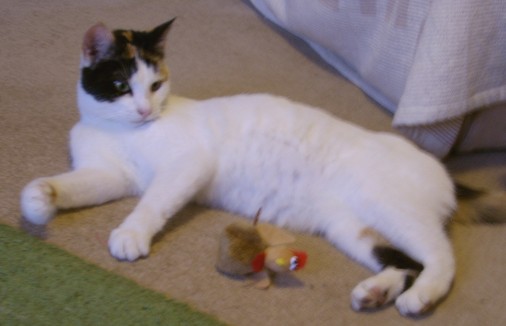
Kitty (Kitty III in this household) was 5 years old, which is younger than I generally adopt cats. However she also needed a new home and she had lived all her life with Mustard so it was easier to settle 2 cats together. Kitty was much more frightened and spent her first days with me pretending to be an invisible statue. I was allowed to reach down the side of a chair and stroke her and was rewarded by purrs and nuzzles. After several days she came out to play. After the arrival of Mr Minns who used to be an outdoor stray, Kitty decided to move upstairs and not go outdoors unless carried! This means disturbed nights when she wants to play by jumping all over the bed. Luckily she's housetrained, although in her case she often uses the plughole of the bathtub - at least it's easy to clean up!
In June 2011, Kitty's lifelong companion, Mustard, died and she became much more demanding of interaction. Unfortunately Kitty showed no signs of becoming friendly with Mr Minns (my downstairs cat) and remains an indoor cat by choice. It took almost 3 years for her to become less food obsessed and lose some of the weight she'd gained earlier on. She has a tendency to give love-bites, especially when being groomed as she likes to groom me in return.
In 2014, Kitty became an only cat after Mr Minns died. In Summer 2014, Kitty went missing for nearly 6 weeks and, despite registering her lost and putting up notices, I had to face the fact she was probably dead. Then, while I was making plans for a pair or trio of oldies, Kitty reappeared - emaciated and too scared to enter the house. Once I brought her inside she refused to leave the living room. It took several weeks for her to regain weight. She had previously been overweight, which has probably saved her life. Sadly the experience triggered FIP (she had the wet form), where the immune system over-reacts to Feline Coronavirus, and a few weeks later she had to be put to sleep because fluid was accumulating in her tissues and making her uncomfortable.
MR MINNS
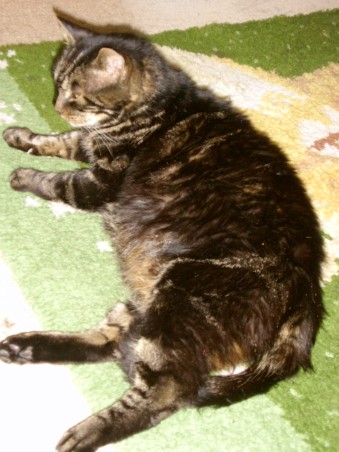
Mr Minns, the big tabby boy, had been living under my hedge in my garden since about 2007, but always ran off if approached. In 2009 he finally made contact, albeit this involved being badly bitten! He was matted and had partial sight in one eye due to an old injury and such a pot belly that I originally thought I had a pregnant female and called the cat Minnie. After worming and lots of patient grooming, Minnie turned out to be Mr Minns. He's probably early teens, a bit arthritic and unable to lose weight despite sensible feeding. He will nip and not give much warning, but he loves being brushed and combed. In July 2010 he was diagnosed as insulin-dependent diabetic. Mr Minns' diabetes was cyclical with his insulin dose being slowly increased and decreased over several months. He has 2 injections each day which means I can't go on holiday (he is temperamentally unsuited to a cattery) and regular blood glucose check every month and a fructosamine test every few months (the latter tests the long term blood sugar levels). He is also very good about letting me test his wee with a dipstick while he's on the tray!
In the evenings. Minns loves lap-time and purrs like an engine. The bites are now rare and only happen when Mr Minns gets over-excited (he hasn't got the hang of gentle love-bites) or if he thinks I am taking food away from him! He and my upstairs cats, Mustard and Kitty III, reached an armed truce and would ignore each other as long as they remained several feet apart, though he was not aggressive they did not respond well to his full-on style of interaction. When Mustard died, Minns and Kitty III called a truce,
Mr Minns was helped from failing health by the vet in May 2014. As well as diabetes, he had hyperthyroid (treated by tablets), a heart murmur, bad teeth (too much of a risk to sedate him for teeth-cleaning) and at the end his kidneys were failing. My big feisty boy had become quite frail and he lacked the energy for giving me whiskery wet-nose kisses. Mr Minns, the cat who asked to come in, had been a happy little soul until the last few days.
SWEEP, BATMAN & ROBIN (DA BOYS)
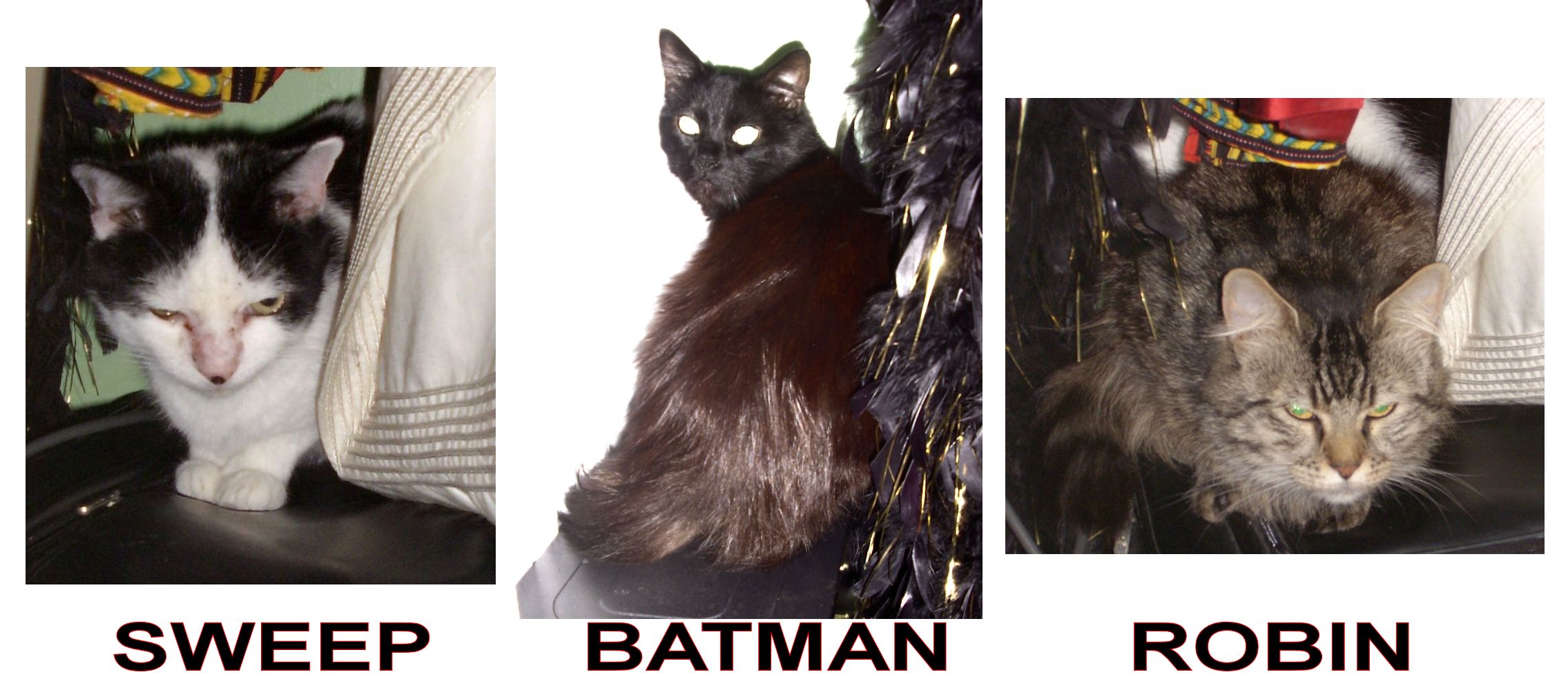
In Summer 2014, a few weeks after Kitty III had returned home, I had a plea for help from a former colleague. Her friend's dad had died, leaving 3 scared indoor cats in an empty flat. His family needed someone to take on the traumatised trio ASAP as the council wanted to reclaim the flat. They already had cats and had tried unsuccessfully to rehome the trio together. It took an hour to catch the cats, and they were installed in my spare room where they hid in the wardrobe. I heard them exploring the room at night and using the litter trays. I sleep in their room for a few hours at night to get them used to me.
Sweep was a 6 year old shorthair; and white with black spots. He took up residence in the wire basket drawer of the wardrobe to observe goings on from a safe height. The boldest of the trio, he ate tuna from my fingers and soon joined me on the bed when I slept in the spare room. When given the run of upstairs, he discovered how to breach the cat-barrier and was usually found on the "wrong side" of it the next morning, having explored the rest of the house during the night. He is now a laid back lap-lover. Batman and Robin were 3 year old fluffies, black and mackerel tabby respectively, and preferred to hide. They took longer to "come around" as they had only been used to one person. Catnip, plenty of toys, food and patience won them over. Robin was first to come out of his shell because he loves being stroked. Batman took a few days longer and proved to be the clown of the trio. Once given access to outdoors for the first time in their lives, Robin presented me with several dead mice and some young pigeons - if I throw these out, he retrieves them and gives them back to me so I have to poke them a few times and then discreetly dispose of them while thanking him for his gift. Batman does everything at high speed and can get from front door, round the side of the house and in the cat flap in the time it takes me to close the front door! Sweep isn't fussed by outdoors - he wants my lap 24/7.
As far as Kitty III (by then ill with FIP) was concerned, invisible cats didn't exist and she never met them, though I had hoped Sweep especially would make a good companion for her.
|
Or use the BACK button on your browser |
|